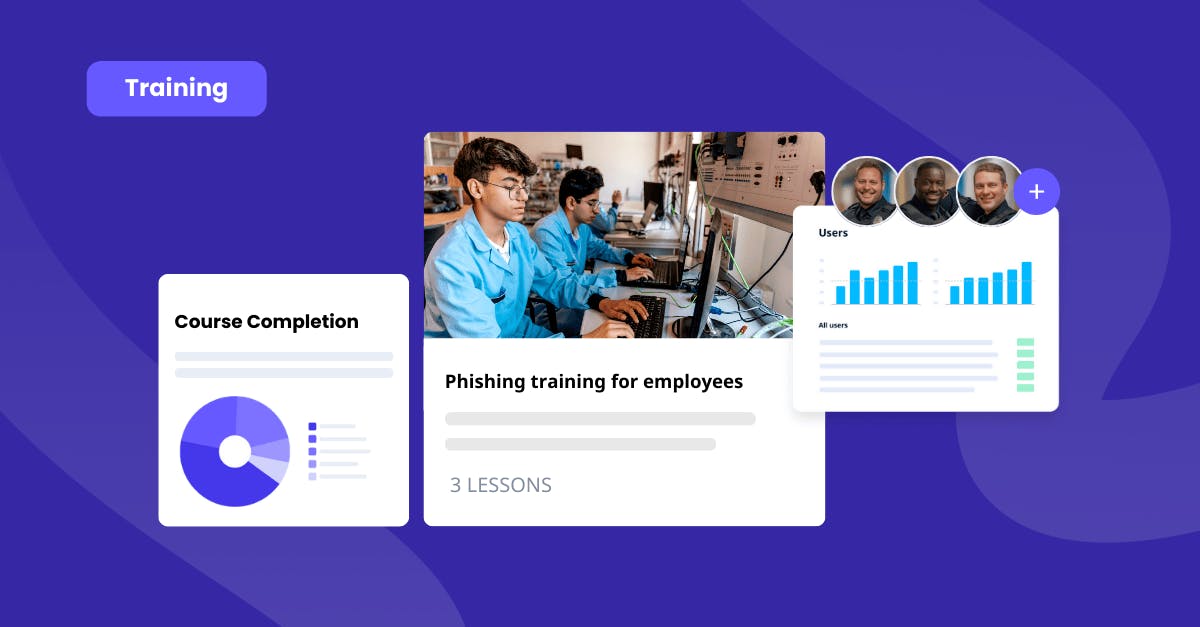Phishing training for employees: A complete guide

Cybersecurity is a shared responsibility. For businesses, just one wrong click can open the door to a major data breach. With phishing attacks on the rise, organizations face a growing threat from deceptive emails and malicious links. That’s why training your teams to avoid giving away sensitive information can be key to keeping both people and company information safe.
Discover how to deliver the right phishing training for employees in this comprehensive guide. Explore the benefits, best practices, and strategies for keeping your operations safe from cyber attacks.
What is phishing training?
Phishing training is designed to help employees recognize and avoid email scams that trick them into sharing sensitive information. These scams, known as phishing attacks, often look like legitimate messages from coworkers, banks, or even company leadership. In reality, these are harmful schemes created by cybercriminals.
Phishing training for employees helps them know what red flags to watch for. This way, they don’t accidentally hand over passwords, financial info, or other confidential personal and company data. Training builds awareness and turns everyday workers into a strong first line of defense against cyber threats.
Why train employees about phishing?
Training employees about phishing is one of the smartest moves a company can make to protect itself from cyberattacks. No matter how advanced your security systems are, it only takes one click on a fake email to put the entire organization at risk.
Cybercriminals target employees with convincing emails, texts, or messages that look trustworthy. Teaching team members how to spot these scams gives them the confidence to pause, think, and act wisely when something seems off. It builds a culture of awareness that benefits both employees and businesses by:
- Reducing the risk of data breaches and protecting company assets
- Preventing ransom payments, legal fees, and reputation damage caused by a phishing attack
- Reducing downtime and business disruption
- Improving incident response to speed up containment when there is a real threat
- Boosting compliance for industries that require phishing awareness training for employees to meet regulations
- Protecting the company’s reputation and customer trust
Types of phishing training
There’s no one-size-fits-all approach to cybersecurity training. To be effective, it should be tailored to your team’s roles, experience levels, and the specific threats your organization faces. Here are the different types of phishing training for employees to kickstart your own program:
1. Simulated phishing emails
In this cybersecurity training, phishing email examples for training are crafted to mimic the look and feel of genuine phishing messages. By sending these simulations in a controlled environment, companies can safely test how employees react when faced with suspicious emails.
The goal isn’t to trick or punish anyone, but to create learning opportunities that build awareness and sharpen instincts. When employees receive a simulated phishing email, their response is tracked. This gives security teams valuable insight into the organization’s overall readiness and highlights areas where more training might be needed.
2. Interactive eLearning modules
Interactive eLearning modules are a powerful tool for teaching employees how to recognize and avoid phishing attacks. These online lessons are designed to be engaging and user-friendly, often including videos, quizzes, drag-and-drop activities, and real-life scenarios. Here, employees actively participate in the learning process, which helps the information stick.
By walking through examples of suspicious emails and being asked to make decisions, employees build practical skills in a low-pressure environment. One of the biggest benefits of interactive eLearning is that it can be done anytime, anywhere, and at each employee’s own pace.
Safety program software solution SC Training (formerly EdApp) gives you access to a powerful creator tool right at your fingertips. It's designed to help you put together expertly designed micro lessons without any prior technical expertise. You can choose from a variety of interactive templates and customize them to fit your specific needs.
3. Phishing awareness workshops
Phishing awareness workshops are live training sessions that bring employees together to learn about phishing threats in an interactive setting. Led by cybersecurity experts or internal IT staff, these sessions often include real-life examples, group discussions, and Q&A segments.
The goal is to create a space where employees can openly ask questions, share experiences, and gain a better understanding of how phishing works and how to stay safe. These workshops are especially effective because they promote active learning and can be tailored to the specific needs or recent threats faced by the company.
Phishing awareness webinars are a great way to keep employees up to date with the latest phishing tactics. Try SC Training’s Virtual Classroom feature, which allows your team to easily join in on training sessions using their mobile device. Whether off-site, fully remote, or working in a hybrid setup, they can access the video training they need to succeed.
4. Just-in-Time Training
Just-in-time training delivers quick lessons exactly when employees need them most—right after they’ve made a mistake. Instead of waiting for the next scheduled training, this gives immediate feedback and a short, targeted learning session. This helps employees recognize past errors and understand how to prevent them from happening again.
This type of training works well because it turns an error into a learning opportunity without being overwhelming. It reinforces the idea that cybersecurity is everyone’s responsibility and that everyone can improve with the right guidance. Over time, just-in-time training is a powerful way to create lasting habits and build a security-first mindset across the entire organization.
5. Post-Training Assessments & Quizzes
Post-training assessments and quizzes are a simple but effective way to reinforce phishing awareness after employees complete their training. These short tests help make sure that key concepts have really sunk in. They also give employees a chance to turn passive knowledge into active understanding.
With SC Training’s Rapid Refresh feature, you can turn quizzes into fun and engaging games. Watch your team tap and drag their way through questions, making learning a more engaging experience. Plus, with a leaderboard to show off their strengths, there’s an extra boost of motivation to perform at their best.
How to train employees against phishing attacks
Discover how to give your employees the phishing training that will keep your company safe from attacks with this list.
1. Make training regular, not one-and-done
One-time training sessions aren’t enough to keep up with ever-changing phishing tactics. Phishing attacks are constantly evolving, so your training should too. Make it a regular part of your cybersecurity routine; quarterly or even monthly updates can go a long way.
Frequent touchpoints help keep phishing awareness top of mind, rather than something employees forget a week after the session. Consistent training also shows that your company takes cybersecurity seriously. When employees see that phishing awareness is treated as an ongoing priority, they’re more likely to engage and apply what they learn.
SC Training’s course management lets you set recurring schedules, publishing dates, and completion criteria for a seamless learning experience. This way, you can start onboarding, training, and upskilling your teams in minutes.
2. Keep the content relatable and realistic
Training works best when it reflects the actual threats employees might see in their inboxes. Use examples that mimic real phishing emails, like fake invoices, suspicious login alerts, or emails pretending to be from company leadership. The more relatable the scenario, the better employees will remember and recognize it in the wild.
When phishing email training feels too technical or abstract, employees can tune out. But when they see examples that could realistically land in their inbox, the training clicks. You’re helping them connect the dots between what they learn and what they might face on the job. This leads to quicker, more confident responses when a real phishing attempt shows up.
3. Encourage a culture of reporting, not blame
It’s important to create an environment where employees feel safe admitting when they’ve clicked something suspicious. Mistakes happen, but they’re valuable learning opportunities. Encourage employees to report phishing emails, even if they fell for them.
When people aren’t afraid of being blamed, they’re more likely to speak up quickly. That makes your response faster and your organization more secure. Promote a “see something, say something” culture where reporting phishing earns positive reinforcement.
4. Mix up the training methods
Different people learn in different ways, so it’s smart to combine various types of training. This variety keeps training from feeling repetitive and stale. It also boosts knowledge retention by appealing to multiple learning styles.
Some employees might learn best through hands-on practice, while others may prefer watching a video or attending a live session. By mixing up your approach, you make sure the message sticks across your entire team. It also keeps things fresh and engaging, so training doesn’t feel like a chore.
5. Celebrate success and improvement
Positive reinforcement goes a long way in encouraging good cybersecurity habits. Celebrate milestones like increased phishing report rates or improved quiz scores. Whether it’s a shout-out in a team meeting or a small reward for spotting a tricky phishing email, showing appreciation makes a difference.
When employees feel recognized for doing the right thing, they’re more likely to keep doing it. Celebrating success also shifts the tone of training from something reactive to something proactive and rewarding. Over time, this builds a sense of pride and ownership in keeping the organization secure.
SC Training’s Achievements feature has custom banners and badges, making recognizing training milestones more fun and motivating. Keep track of everyone’s progress and easily export achievements, all while monitoring individual performance.
Boost your defense with phishing training
Cyber safety statistics show that one data breach can cost your business USD 5 million on average. From entry-level staff to executives, knowing how phishing works and how to respond keeps the company less likely to fall victim to these costly breaches or data leaks. This is why phishing training doesn’t just keep inboxes safe, it protects the entire business.
Phishing training platforms like SC Training have free cybersecurity training courses that house interactive lessons to reinforce safe behavior and respond effectively to potential threats. Packed with real-world examples and ongoing assessments, these training courses are a must to keep company data safe.
Strategies to combat phishing attacks
SC Training houses a comprehensive course built to teach your teams how to combat phishing attacks. This three-part training explores the most common phishing attacks and guides employees on how to stay ahead of phishers. It’ll help learners recognize the signs of phishing attempts, identify emerging phishing trends, and apply precautions to prevent attacks.
Author
Bea Garcia
Bea Garcia is a content specialist at SC Training, a cutting-edge e-learning platform commited to delivering experiences that empower frontline teams. She specializes in creating tailored content for the hospitality, retail, and SaaS industries, offering training solutions that address the unique challenges of each sector. Beyond writing, she spends her time trying out recipes and watching films.
